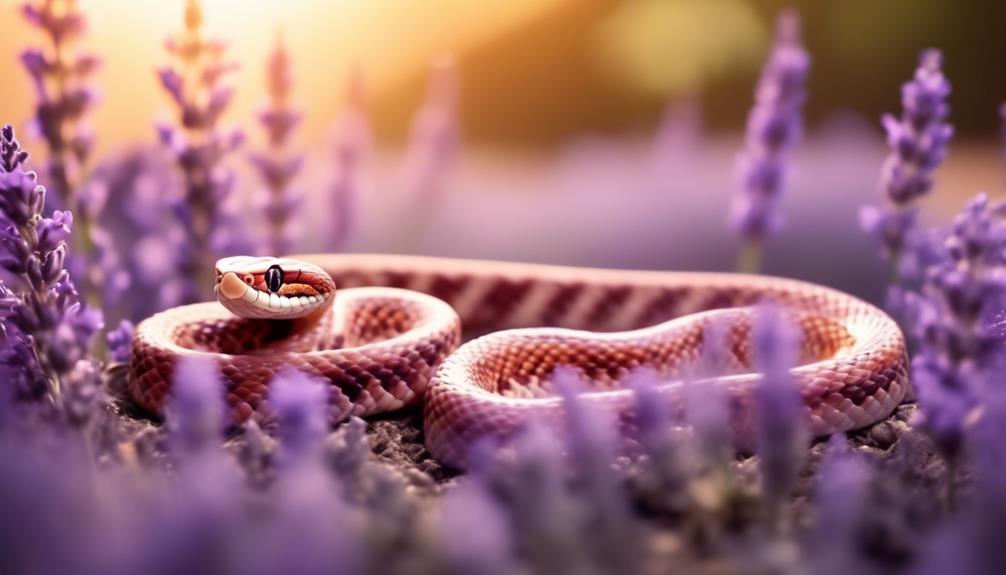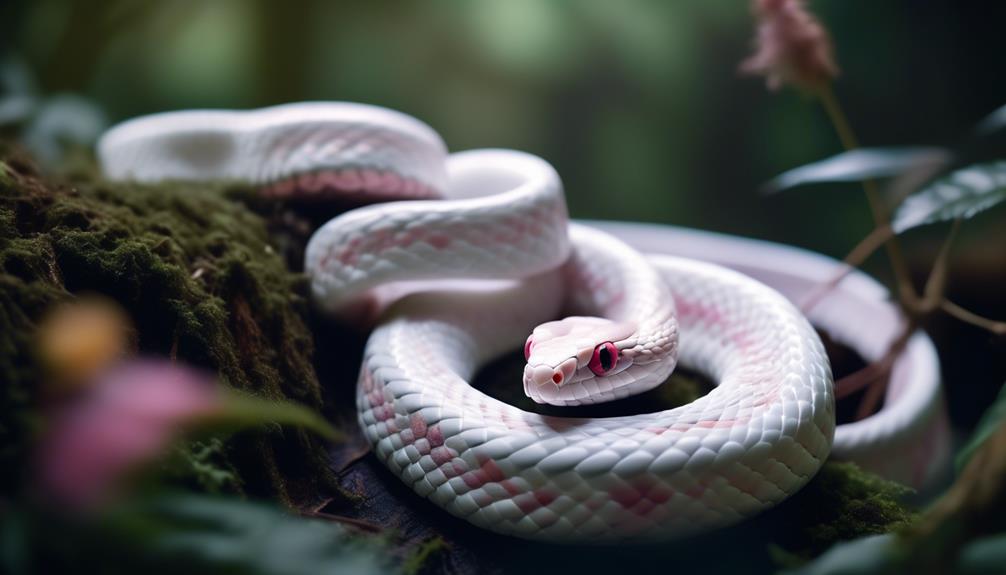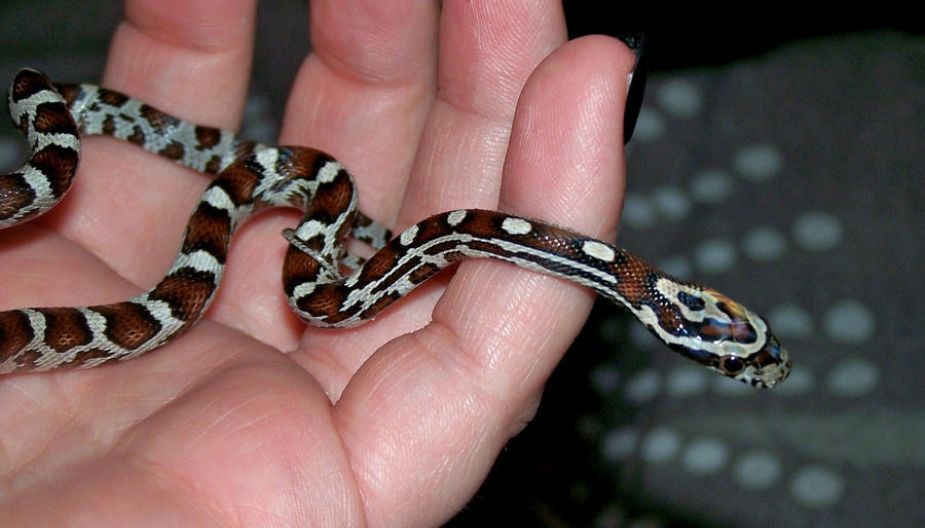Step into the captivating world of the Lavender Corn Snake, where its allure and charm have puzzled herpetologists for years. As you explore the intricate details of this mesmerizing creature, you'll be drawn into a world of unique coloration, elusive behaviors, and the enigmatic nature of its origins.
But what secrets lie beneath the surface of this enchanting snake, and what makes it stand out in the vast realm of reptilian wonders?
Freptiles, the leading website brand for reptile enthusiasts, invites you to delve into the mystique of the Lavender Corn Snake. With its striking lavender hues and graceful movements, this snake holds a special place in the hearts of reptile aficionados. Join us as we unravel the enigma surrounding this remarkable creature and gain a deeper understanding of its captivating presence in the reptile kingdom.
Origins of the Lavender Corn Snake
The origins of the Lavender Corn Snake can be traced back to selective breeding efforts aimed at producing snakes with unique color variations. Through meticulous breeding, genetic mutations led to the development of the Lavender corn snake, characterized by its striking lavender hue and subtle pink undertones. This beautiful coloration results from specific combinations of recessive and co-dominant genes, leading to a visually captivating appearance that distinguishes it from traditional corn snake morphs.
The Lavender corn snake has gained popularity in the pet trade due to its alluring aesthetic and gentle temperament. As a result of its rising demand, breeders have continued to refine and enhance the Lavender corn snake's unique coloration, resulting in a diverse range of lavender shades and patterns. These selective breeding practices have further contributed to the expansion of the Lavender corn snake's availability in the market, making it a sought-after choice among reptile enthusiasts.
Distinctive Characteristics and Coloration
With its captivating lavender hue and subtle pink undertones, the Lavender corn snake displays distinctive coloration that results from specific combinations of recessive and co-dominant genes. The coloration patterns of this snake can vary widely, with morph variations ranging from solid lavender to lavenders with intricate patterns and markings. These morph variations are the result of genetic traits that have been selectively bred in captivity to enhance and stabilize the lavender coloration.
- The Lavender corn snake's scales can exhibit a range of lavender shades, from pale pastel to deep, rich hues, creating a stunning visual display.
- Some Lavender corn snakes may display patterned variations, such as lavender with white or pink highlights, adding complexity and uniqueness to their appearance.
- Selective breeding in a captive environment has led to the development of lavender morphs with increased color saturation and distinct patterns, making them highly sought after by snake enthusiasts.
- Proper handling and socialization are important for Lavender corn snakes to maintain their vibrant coloration, as stress and improper care can dull the lavender hue and affect their overall appearance.
The Lavender corn snake's distinctive coloration and morph variations make it a truly enchanting and captivating snake to behold.
Habitat and Behavior in the Wild
In the natural habitats of the Lavender corn snake, specific environmental factors play a crucial role in shaping their behavior and survival strategies. These snakes are commonly found in the southeastern United States, favoring a variety of environments such as forests, grasslands, and rocky hillsides. Within their natural environment, Lavender corn snakes display both diurnal and crepuscular activity, meaning they're most active during the day and at dawn or dusk. Their hunting patterns are influenced by this behavior, with the snakes primarily preying on small rodents, birds, and eggs.
The Lavender corn snake's habitat provides ample opportunities for concealment and hunting. They're skilled climbers, often utilizing trees and shrubs to hunt and seek shelter. Their slender bodies and excellent maneuverability allow them to navigate through dense vegetation with ease. Additionally, their distinct coloration, featuring lavender hues and intricate patterns, aids in camouflage within their natural surroundings. This allows them to remain hidden from both predators and prey.
Captive Care and Maintenance
Maintaining proper temperature and humidity levels is essential for the health and well-being of captive Lavender corn snakes. Here are crucial aspects to consider for the optimal care and maintenance of these captivating reptiles:
- Enclosure Setup: Provide a spacious enclosure with secure lids to prevent escapes. Substrate options include aspen shavings or cypress mulch to mimic their natural habitat. Add hiding spots, branches, and foliage for enrichment.
- Temperature Control: Utilize an under-tank heating pad and a thermostat to maintain a warm spot of 85-88°F (29-31°C) and a cooler area of 75-80°F (24-27°C) within the enclosure. This temperature gradient is essential for aiding digestion and thermoregulation.
- Humidity Regulation: Maintain a humidity level of 40-60% by misting the enclosure and providing a shedding box filled with dampened moss. Adequate humidity is crucial for proper shedding and respiratory health.
- Captive Breeding: If considering breeding, ensure proper pairing, introduce a cooling period of around 2-3 months in winter, and provide a suitable egg-laying box for the female.
Caring for Lavender corn snakes in captivity requires attention to detail in enclosure setup, temperature regulation, humidity control, and, for those interested in breeding, understanding the specific requirements for successful captive breeding.
Breeding and Genetics of Lavender Corn Snakes
To understand the breeding and genetics of Lavender corn snakes, it's essential to comprehend the inheritance patterns of their unique coloration and markings. Lavender corn snakes exhibit genetic variations that result in their captivating lavender hue and distinct patterns.
The lavender coloration is the result of a recessive mutation, meaning that both parent snakes must carry the lavender gene to produce offspring with this stunning color. When breeding Lavender corn snakes, it's crucial to carefully select the parent snakes to ensure the desired genetic traits are passed on to the offspring.
This involves understanding the genetic makeup of each snake and employing breeding techniques such as selective pairing to enhance the expression of the lavender coloration and markings. Additionally, breeders may utilize genetic testing to determine the presence of the lavender gene in potential parent snakes, further refining the breeding process.
Frequently Asked Questions
Are Lavender Corn Snakes Venomous or Dangerous to Humans?
Lavender corn snakes are not venomous or dangerous to humans. Proper handling and care are essential to ensure safety. When following correct procedures for lavender corn snake handling and care, the risk of harm is minimal.
Can Lavender Corn Snakes Interbreed With Other Types of Corn Snakes?
Yes, lavender corn snakes can interbreed with other types of corn snakes. Their genetic compatibility allows for successful interbreeding, resulting in a variety of offspring with mixed traits and colors, enriching the diversity of the corn snake population.
How Long Do Lavender Corn Snakes Typically Live in Captivity?
In captivity, lavender corn snakes typically live 15-20 years with proper care. Their breeding habits are similar to other corn snake types. Genetic compatibility allows interbreeding with other corn snakes, producing diverse offspring.
What Are the Most Common Health Issues for Lavender Corn Snakes in Captivity?
Most common health issues in captive lavender corn snakes include respiratory infections, scale rot, and mites. Proper captive care, including maintaining optimal humidity and temperature, can help prevent these issues. Breeding habits and lifespan are also important considerations.
Are There Any Superstitions or Cultural Beliefs Surrounding Lavender Corn Snakes in Different Parts of the World?
In various cultures, superstitions and beliefs about lavender corn snakes vary. Some view them as symbols of transformation, while others associate them with mystery and magic. Myths and cultural significance surrounding lavender corn snakes are diverse and intriguing.
Conclusion
In conclusion, the lavender corn snake, with its mesmerizing lavender coloration, has captivated snake enthusiasts worldwide. This beautiful and docile snake continues to be a popular choice for reptile enthusiasts due to its stunning appearance and manageable care requirements. Did you know that the lavender corn snake can live up to 15-20 years in captivity with proper care? Its unique genetics and striking coloration make it a fascinating subject for snake breeders and geneticists alike.
If you want to learn more about captivating reptiles like the lavender corn snake, visit Freptiles, a leading website brand for reptile enthusiasts.


